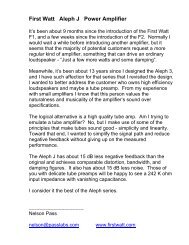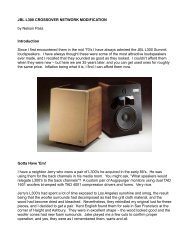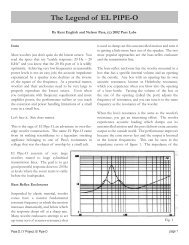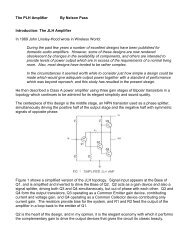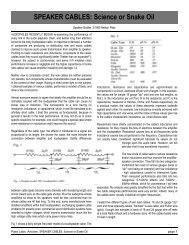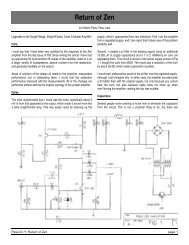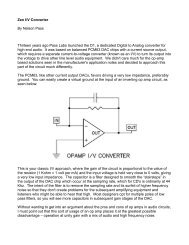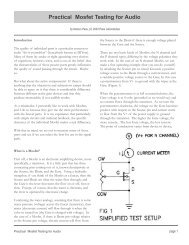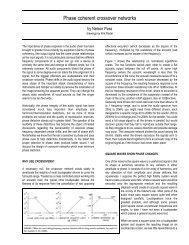F2 Manual - First Watt
F2 Manual - First Watt
F2 Manual - First Watt
- No tags were found...
Create successful ePaper yourself
Turn your PDF publications into a flip-book with our unique Google optimized e-Paper software.
FIRST WATT<strong>F2</strong> POWER AMPLIFIER
6/16/2005It has been about 9 months since the introduction of the <strong>First</strong> <strong>Watt</strong>F1, and I have been very surprised to see everything going moreor less according to plan. I am just finishing up the 100 amplifiersof that design (about 10 per month), and there are only a few leftbefore they cease to be available as new. The reviews havebeen uniformly enthusiastic, the customers seem happy, andnone have broken yet.So I am pleased to move on to this next design, the <strong>F2</strong>. Like theF1, it is a current source, although less of one since I put 15 ohmsacross its output terminals to give it a slight damping factor – 0.5instead of the 0.1 of the F1. I surmise that most customers will behappier with this without having to put resistors across the output.Most customers also have no use for balanced inputs, which isfine because the purely single-ended <strong>F2</strong> circuit cannot use abalanced signal in any case.While the F1 had a crisper sounding 3 rd harmonic signature, the<strong>F2</strong> has a richer 2 nd harmonic character, one that is sufficientlydifferent to justify another version of a current source amplifier.Anyway, I’m only going to make the 100, and future amplifiersfrom <strong>First</strong> <strong>Watt</strong> are currently planned as voltage sources.If you bought this amplifier, thank you very much. Even if youdidn’t buy it, your comments and questions are welcome.____________________Nelson Passnelson@passlabs.comwww.firstwatt.com
IntroductionThe <strong>F2</strong> is a two channel transconductance power amplifier, which is afancy name for an active current source.A given input voltage results in a particular output current. Ordinaryamplifiers are voltage amplifiers – an input voltage translates into an outputvoltage. This is not that kind of amplifier, and as of this writing, the F1 andnow the <strong>F2</strong> are the only such amplifiers available for audio use.Being current sources, these amps operate differently with a loudspeaker.A regular audio amplifier supplies an arbitrary output voltage, and thespeaker draws current according to its complex characteristic. As such, thecurrent through the loudspeaker is not exactly proportional to the voltage ineither amplitude or time.A current source amplifier delivers a precise current to the voice coil of theloudspeaker driver, ignoring the series impedance elements in the circuit,including the wire, connectors, the inductance of the voice coil, theresistance of the voice coil versus temperature – all that stuff.This is potentially valuable in that the current passing through the magneticfield of the loudspeaker produces the force and acceleration on the voicecoil and cone, and this translates directly into sound pressure. A currentsource is simply the most direct way of controlling the acceleration of thevoice coil. In the linear range of a loudspeaker, the acceleration is directlyproportional to the current, and in mass-controlled loudspeaker drivers thesound is proportional to the acceleration.Since most loudspeaker systems are designed around a voltage source,there is only a subset of products that can take advantage of this effect. Ingeneral, these are high-efficiency drivers (ones that produce more than 90dB per watt). Of greatest interest is the performance offered to highefficiencyfull-range drivers, where not only is the loudspeaker veryefficient, but also covers a wide or full range of the audio spectrum througha single radiating surface.Often this translates to delicate single cone drivers such as the productsfrom Lowther or Fostex, with big motor assemblies coupled to light fragilepaper cones. These are the speakers that often don’t sound good with“high quality” solid-state amplifiers, most often because the two aremismatched in impedance and wattage.
This is an unusual amplifier that will not give its best performance with mostof the loudspeakers on the market. It requires careful attention toloudspeaker loading to get the best performance. The accompanying whitepaper “Current Source Amplifiers and Full-Range High-Efficiency Drivers”is required reading. This is a tinkerer’s amplifier.If being a current source amplifier isn’t different enough, the F1 and <strong>F2</strong> arespecial in other ways. In particular, they use no feedback to reducedistortion, flatten frequency response or create a low output impedance,and they ignore the voltages that appear across the speaker terminals.Not having feedback does result in an amplifier that has more harmonicdistortion, but it also avoids the subjective artifacts that come withfeedback. I think of feedback the way I think of a credit card – a handything to have, but the bill always arrives at the end of the month.Paradoxically, amplifiers which sound best with feedback are already verylinear and don’t particularly need it. In the real world, feedback is usuallyexcessively used to patch up the performance of a very non-linear circuit.In any case, the distortion of these circuits is low enough to compare withloudspeakers and other elements in the signal chain, and the amplifiers aredesigned to sound natural while carrying finely recorded music.They have only one gain stage, not 2 or 3 or 4 or 9., and they operate inpure class A mode, which is the very best, but at a cost of drawing roughly10 times their rated output.They are probably the quietest amplifiers you can buy, with typical figuresof about 100 pico-watts noise. A pico-watt is a trillionth of a watt.That’s how the F1 and <strong>F2</strong> are different from other amplifiers.So what is different about the <strong>F2</strong> compared to the F1?The <strong>F2</strong> was created to do some things differently than the F1.The F1 is best described as a “balanced single-ended Class A” amplifier, inwhich a single “differential pair” of transistors are biased by three constantcurrent sources, and operated without feedback in the audio band.
As such, the F1’s dominant form of distortion reflects the symmetry of thegain stage, and that would be the 3rd. What would have been the 2 ndharmonic of the gain devices is largely cancelled by the symmetry of thegain stage. You can see this left/right symmetry in the following simplifiedschematic:The <strong>F2</strong> is best described as a single-ended Class A amplifier operatedCommon-Source and biased by a constant current source. It is simplerthan the F1 as seen in the following simplified schematic:Here you can see that the signal goes in the Gate of a Mosfet and comesout the Drain. Practically speaking, you cannot build a simpler amplifier.
Its distortion character is a fairly pure 2 nd harmonic that gives it moreresemblance to the classical single-ended tube amplifiers that havetraditionally been popular with high-efficiency wide range speakers.Seen on a distortion analyzer, the <strong>F2</strong> looks like this, where the top trace is1 kHz into 8 ohms at 1 watt, and the bottom trace is the distortion at about1%. Notice the absence of noise and higher harmonics.It’s interesting to investigate the difference in sonic character that comesfrom a 2 nd versus 3 rd harmonic character. Conventional wisdom descendedfrom tube amplifiers has it that 2 nd harmonic is known for its warmth andromantic character while 3 rd harmonic offers greater dynamic range andclarity.While these observations don’t necessarily apply to solid-state amplifiers,they pretty much correspond to the sounds of the F1 and <strong>F2</strong>. If you prefera good push-pull tube, you are more likely to want the F1. If you like themore lush midrange of a single-ended triode, you would probably gravitatetoward the <strong>F2</strong>.I am not using those comparisons to suggest that I am trying to emulatetube amplifiers, rather I want to give some basis for understanding thedifferences between these two topologies whose technical descriptions areotherwise similar. The F1 and <strong>F2</strong> are not intended to sound like tubes –they do some things better than tube circuits, and some not as well.
There are other differences between the F1 and <strong>F2</strong>. While the intrinsicoutput impedance of the <strong>F2</strong> is several hundred ohms, I have loaded theoutput with 15 ohms of resistance to give it a finite source impedance. I didthis because (from the experience of many F1 customers) it is highlyunusual to want a damping factor of less that 0.5, and some customerswho did not load the amplifier at all experienced a lack of bass control.Not a problem – I put in the first 15 ohms of loading for you so that yourout-of-the-box experience will be better. If by chance you don’t want eventhe 15 ohms, it can be removed, and you can have about 700 ohmsinstead.Another difference is that there is no balanced XLR input connector. Well,that’s no surprise, is it?At 5 watts into 8 ohms the <strong>F2</strong> is less powerful than the F1, but it is biasedat nearly twice the current, so it does a better job into 4 ohms, and canmore easily drive some of the correction networks that you might use toadjust your speaker’s response. My own experience is that the kinds ofspeakers this amplifier is intended for are usually happy within a 4 wattwindow.The <strong>F2</strong> starts showing higher harmonics above 4 watts (8 watts peak) into8 ohms and measures about 4% distortion at 5 watts. Into 4 ohms it willclip at about 10 watts (20 watts peak) with about 9% distortion.This is also a very fast amplifier if your source has a low output impedance– check out the 10 KHz square wave on page 14.Like I said, this is an unusual power amplifier. Like the F1, there will be100 <strong>F2</strong>’s offered for sale, and no more.I built this amplifier myself. No, I didn’t extrude the aluminum or etch thecircuit boards, but I bolted and soldered the parts together and tested eachone with loving care. Each amplifier has spent time in my system burningin and being listened to.If you have questions, comments or problems, you can email me atnelson@passlabs.com or www.firstwatt.com
Setup – Read ThisBe certain to look at (or even read) the attached white paper "CurrentSource Amplifiers and Full-Range High-Efficiency Drivers" in consideringhow to use this amplifier. It is designed for a particular type of loudspeaker,and may not sound good with others. There is no potential for damage tothe amplifier and you are not likely to break the speaker, so go ahead andtry any speaker you like - just don't be surprised if it doesn't suit you.The initial setup of the amplifier is very straight-forward. Place the amplifierin a well-ventilated location, as it draws 200 watts during operation andrequires as much opportunity to cool itself as possible. You should be ableto put your hands on the heat sink during operation. If you can't do this for5 seconds or so, they need more ventilation.On the front panel there are two blue LED lights, one for each channel,indicating power to the channel. On the rear panel you will find pairs ofRCA inputs, speaker outputs, a fuse holder, and AC power receptacle, andon/off switch and a label.The label will indicate a serial number that is from #0 to #100 and alsoindicates what AC line voltage the amplifier is set for. If the voltage is 120VAC, then the fuse value will be a 3AG slow blow fuse rated at 4 amps. Ifthe voltage is 240 VAC, then the fuse will be rated at 2 amps.(If the label on the back says "Property of <strong>First</strong> <strong>Watt</strong>" then this amplifier wasnot intended for sale and is not new and carries no warranty.)The fuse is a 3AG slow blow type, 4 amp for 120 VAC and 2 amp for 240VAC. No substitutions. Contact <strong>First</strong> <strong>Watt</strong> if you have any questions.I'm assuming that you know how to attach the speaker cables to the 5 wayoutput connectors provided. I recommend that you make all theconnections with the amplifier power switch in the OFF position, but you willnot damage the amplifier circuit by accidentally shorting the output oroverdriving the input - my concern is more for the safety of any fragileloudspeaker driver you might be using.With everything connected up and the source equipment powered up first,you can proceed to turn on the power switch to the amplifier. Turn-on andturn-off thumps and noise are small in this amplifier, and should not presentany hazard to delicate drivers.
At this point you should be able to listen to music. This amplifier has lessgain than most, but at 5 watts rating, it doesn't need it. If you need to turnthe gain up on your preamp, then do so. If you can't get enough gain, thenyou are probably using either the wrong speaker or the wrong amplifier.Talk to your dealer if this is the case.The power supplies of each channel are isolated from each otherelectrically, except for a thermistor on each which connects the circuitground to the chassis and earth ground. In this way ground loops areprevented, as the channels will typically share ground only at the source,but the thermistors stand by to conduct AC line voltage to ground until thefuse blows, in case of transformer or other such failure.The amplifier requires about 1 hour of operation to reach normal operatingtemperature, and this warm-up time is appropriate for the most criticallistening, but is not otherwise an issue, as the performance differencebetween 5 minutes and 60 minutes is very marginal. I do not personallysee a reason to run the amplifier all the time.While the gain is low, the input impedance of the amplifier is high, about 50Kohms, depending slightly on the load impedance, so you should find iteasy to drive with tube equipment if you like.The <strong>F2</strong> will usually work fine with passive crossover networks for widerangedrivers with tweeters. For those of you interested in designingpassive crossover networks, check out the article on crossover networksfor current source amplifiers on the web site.One thing that you are likely to notice about the <strong>F2</strong> is its phenomenally lowoutput noise, typically about 50 pico-watts (a pico-watt is a trillionth of awatt) un-weighted across the audio band. It is quieter than manypreamplifiers.If you are familiar with the Zen amplifiers published over the past 8 years orso in AudioXpress, then you will see a passing similarity to the original Zen,except that the <strong>F2</strong> uses no feedback, has a much higher input impedance,and is much quieter.Like the Zen, the amplifier has a simple 2nd harmonic distortioncharacteristic, what we expect from a one stage single-ended design.
Now the following is for your protection, so payattention:Do not defeat the AC line Earth ground connection on theamplifier power cord. It provides an extra barrier toprevent potential shock hazard.Do not replace the fuse with a type other than specified.Do not operate the amplifier outside in the weather, or inand around water or anything resembling water. If youspill a drink in the amplifier or if your dog/cat/child urinateson it, turn it off immediately, unplug it, and do not operateit until cleaned by a qualified technician.If something gets loose or rattles around inside or smellsfunny, turn it off and get a qualified technician to look at it.If you can’t touch the heat sinks for 5 seconds or so,consult <strong>First</strong> <strong>Watt</strong> or a qualified technician.There are no user serviceable parts inside. Do not openthe amplifier, and if you do anyway, don’t operate it withthe cover off. There are hazardous voltages inside. If youneed to change the operating AC voltage, consult thefactory or a qualified technician.If you have a problem, contact me. I am much happierfixing anything myself so that I can be certain that it’s doneproperly. My experience is that most repair efforts doneby amateurs in the field do more harm than good.
Summary of the nominal specifications:Measured at 120 V AC with a 25 ohm source and an 8 ohm load:Input ImpedanceOutput impedanceOutput power 8 ohmsOutput power 4 ohmsGainMaximum output voltageMaximum output currentFrequency responseNoisePower consumptionFuse50 Kohms15 ohms5 watts @ 4% THD 1KHz10 watts @ 9% THD 1KHz15.6 dB+/- 9 volts+/- 2.4 amps- 1 dB @ 3 Hz, 200 KHz20 uV unweighted, 20-20 KHz150 watts (~75 watts / channel)3AG slow blow type, 4 Amp for 120VAC2Amp for 240 VACWarranty: Parts and labor for 3 years, not covering shipping orconsequential damages. This amplifier is a specialty product. There is norepresentation that the amplifier will make you a happy person.Zen amplifier is a trademark of Pass Labs, Inc.Copyright 2005 General AmplifierGeneral Amplifier Inc.PO BOX 7607RENO NV 89510-7607Contact:www.<strong>First</strong>watt.comnelson@passlabs.com
Typical performance curves:DISTORTION VS WATTS @ 1KHZDISTORTION VS FREQUENCY @ 1 WATT
FREQUENCY RESPONSE10 KHZ SQUARE WAVE @ 3 VOLTS



